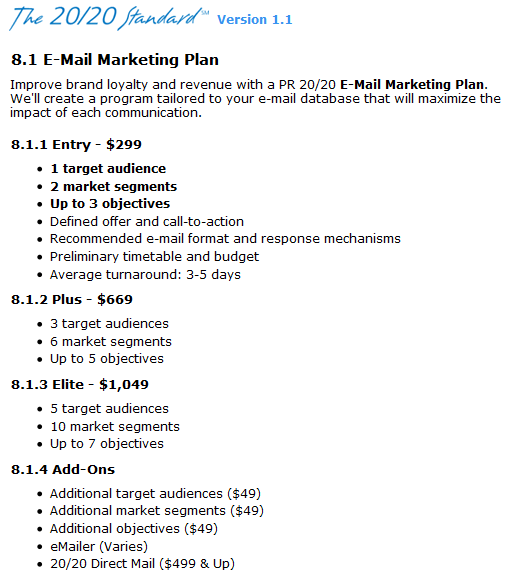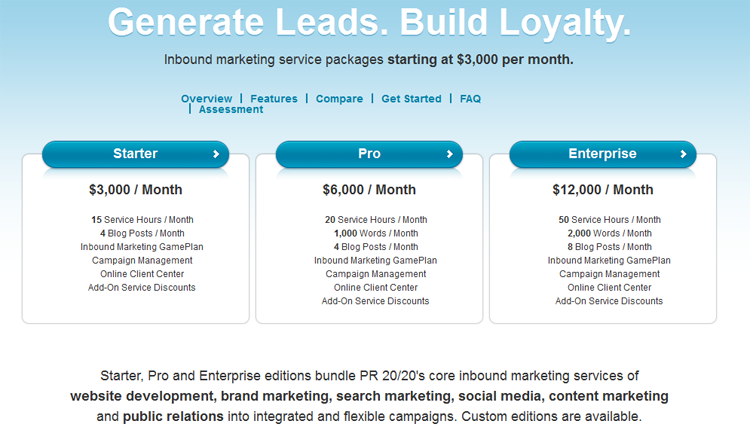 This case study is very interesting. It is about how an agency learns from which sales/marketing models are working in other industries and applies them to the agency’s business. They have done this twice. If you are looking for ideas on how to do things differently, this article will be great for inspiration.
This case study is very interesting. It is about how an agency learns from which sales/marketing models are working in other industries and applies them to the agency’s business. They have done this twice. If you are looking for ideas on how to do things differently, this article will be great for inspiration.
Paul Roetzer is the founder of the PR & marketing firm PR 20/20, a twelve-person agency. From the beginning, they focused on small businesses that needed cheaper solutions and were not well served by the larger PR agencies.
This article is based on an interview from Trent Dyrsmid of BrightIdeas. This article also has some slight interpretations.
The Original “20/20 Standard” or Selling Services
PR 20/20 designed and setup a model based on standardized services and fixed prices. They had 105 different services, classified in 19 categories. The idea was to sell like a store. One customer goes, sees the different services offered, chooses the one that fits him the best and buys it the same way he would buy in a grocery store. The product description specifies exactly what it includes.
When they implemented this model, services looked like they were part of a menu where services such as brand marketing, public relations, email marketing, and others were listed one after the other.
Clients could click on the service they were interested in from the list and then could see the available prices from which they could choose. Each service had different price levels. Below you can see what they included in one of the 19 categories which, was the “Email marketing” category.
The new Service Type Model or Selling by Project:
Recently, PR2020 has evolved into a different type of service/pricing model. The main reason for this has been that they wanted to go to recurring revenue services, since this would let them focus more on the customers and less on the selling process. Now they offer only three services which are a bundle of many different services. Each bundle has different features based on the set price. In this new model, a client pays a fixed price per month, and then receives all the services included in the package every month. Below you can see how the service pages look now.
How does it work?
- A client chooses the plan which is most appropriate to his/her needs.
- PR 20/20 designs and implements the selected plan.
- PR 20/20 measures how efficiently they turn one hour of service into X dollars of revenue, even if the client is not paying the hourly rate.
Their stand on retainers:
Much of what PR 20/20 is doing is directed towards retention, which means that instead of spending their time trying to find new accounts, they work more on the growth of their existing accounts. Paul believes that the longer you retain a client, the more developed is the scale of economies.
Paul is focusing the agency more on profitability than on growth. He believes that agency owners must think about building a solid infrastructure that can sustain growth and be more profitable than the average firm.
Conclusion:
What I find specially interesting about Paul and Pr2020, is how he took a model from another industry, and applied it to the services business, allowing people to buy PR/Marketing services like they would purchase an off the shelf product. This creative approach helped his agency differentiate from the rest, gain the first customers, and be more appealing to a group of customers. For those customers who prefer to buy services this way, he will have very little competition.
The problem with this approach is that once they sell a service as a packaged deal, there is no real incentive for the customer to continue buying, so PR2020 is changing the model to sell based on recurring plans that already include some services. They have gone from over 100 services, sold as products to just 3, that offer a couple of services bundled together, Another interesting thing is that they have changed their focus to recurring charges, so they do not have to sell all the time. Again, another interesting move from PR2020, who differentiates his agency from all the others, is taking a commercial model that is working in other industries, for example, software as a service, and applying it to a service firm.




Comments are closed.